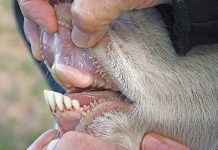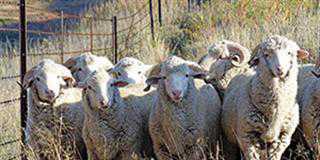Leon Trollip and his son Leon Jr prove that diversification can reduce risk. They’ve successfully incorporated Dohne Merinos as a livestock enterprise alongside their irrigated pastures and crop production enterprises, on their 100ha Sanddraai irrigation farm in the Luckhoff district.
The Van der Kloof irrigation scheme provides water to produce popcorn maize and wheat as cash crops, and oats and lucerne as pasture. Popcorn is the main cash crop, while 600 Dohne Merino ewes and followers graze mainly on lucerne between October and April. For the rest of the year, they run on oat pasture and maize stover. Lambs are finished for the market on balanced feed rations on the farm’s feedlot.
Matings and lambing times
Sanddraai’s Dohne Merinos are run on a breeding system of three lambings in 24 months, which means 300 of the 600 ewes are mated every four months. The first groups lamb in March and July, the second in November and March, and the third in July and November. These programmes ensure that each ewe is mated three times in 24 months. Rams are used at a rate of 5% in a 34-day mating period to cover two cycles per ewe.
Feeding and management
A comprehensive vaccination and drenching programme ensures optimum health in the flock. Ewes receive strategic feeding three weeks before mating, at which time they’re given Multimin. Ewes lamb on lucerne between October and April, and ewes with multiples are enclosed in pens for 10 days before going back onto lucerne pasture. Lambs receive creep feed from 10 days of age. Ewes lambing between May and September graze on maize stover and are then put on oats pasture three weeks before lambing.
Sheep are also shorn every eight months and lambs are shorn before marketing. Sheep receive an all year round ad lib lick (also when on lucerne pastures) of 1 000kg maize meal, 300kg salt, 3kg sulphur and a 1,5kg calcium source. Lucerne pastures are grazed from flowering stage to shortly before the sheep are moved onto fresh pasture. Sheep mortality due to prussic acid poisoning has been reduced to only 0,35% per year. This is achieved by making lick consistently available and regularly irrigating the lucerne to prevent it from wilting.
Lamb production
A conception rate of 86% and lambing percentage of 165% (ewes scanned in lamb) is the norm. The lamb mortality rate until weaning varies from 10% to 15%. Lambs are weaned at 14 weeks, when wether (hamel) lambs and cull ewe lambs go to the feedlot to be finished off for the market on a complete feed ration of grain and hay, which are both produced on Sanddraai.
Lambs are marketed at liveweights varying from 47kg to 52kg and the dressing-out percentage varies from 47 to 50. Sheep are marketed through the Hopetown abattoir. The current price for lamb carcasses is R39/kg, resulting in a gross income of R858/lamb. The wool/meat income ratio of the flock is 20% wool and 80% meat, in line with the results achieved by study groups of woolled sheep flocks producing top gross margins elsewhere in the country.
Ram cost per lamb produced
The Trollips spend on average R8 000 per Dohne ram bought and they use 15 rams in a multiple mating system of six matings in 24 months. The total cost for 15 rams comes to R120 000. These rams are used for about four years before being replaced. Calculated according to conception and weaning rates indicated, the flock produces around 1 150 lambs per year. Assuming that every ram produces 77 lambs per year (according to matings and weaning results described), one ram sires about 308 lambs in the four years.
The ram cost, calculated as a percentage of gross income per lamb yielded over this period, is 3% (R8 000 ÷ 308 = R26) considering that the lambs average a gross value of R858 each. The cost of R26/lamb will be further reduced if the wool component is included in this calculation. The cost of a ram, calculated as a percentage of lamb income, is quite low compared to other input costs. It enables the Trollips to buy rams from the top 10% available on sales – rams with optimum production figures, which are needed to operate an efficient meat/wool production system.
Income per ewe and per hectare
The gross farm income (GFI) per ewe is R1 775 per year, or R26 624/ ha.To differentiate between the nett economic performance of the Dohne flock and other enterprises on Sanddraai (interest on capital excluded), operating costs for the sheep are allocated as follows: water, electricity, fertiliser, seed, medicine, feed, labour, packaging and shearing, which amount to R550,84/ewe/year, reflecting a nett operating profit of R1 224,16/ewe, or a nett operating profit of R18 237,60/ha. As sheep also graze on areas of the farm where cash crops and pastures are grown, the allocation of sheep on pastures comes to 15 ewes per hectare. This allocation could differ from one mixed farming enterprise to another.
Profitable diversification
The outstanding and consistent economic performance of the sheep enterprise offers the Trollips a highly profitable diversification to limit the risks associated with cash crop production. Leon puts it into perspective by pointing out that, at the current maize price of R1 100/t and a yield of 10t/ha under irrigation, maize would yield a nett farming profit of R3 600/ha.
Wheat production under irrigation with a yield of 6,5t/ha sold at the current price of R2 200/t would yield the same nett farming income. Low margins of this nature increase the risk of major losses when input costs and commodity prices fluctuate widely during the production period. The Dohne Merino enterprise, by comparison, yields a nett income of R18 237/ha, interest on capital excluded.
Farmers producing cash crops under irrigation can diversify by incorporating Dohne Merinos with great success on lucerne pasture, limiting input costs and increase nett farming income. Leon attributes the low input cost to the non-selective grazing habits of the Dohne and its ability to convert inferior fodder into energy.
Contact Leon Trollip on 082 332 7817.













